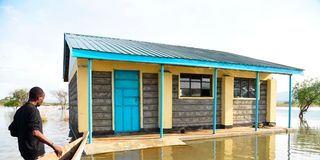Search for justice: Report reveals spike in climate lawsuits

Nosukuro primary School in Lake Baringo submerged in water on October 14, 2020. Representatives of the Illchamus and Tugen communities sued the government of Kenya over the flooding of the lake.
What you need to know:
- Representatives of the Illchamus and Tugen communities sued the government of Kenya over the flooding of Lake Baringo, one of the two freshwater lakes in the Rift Valley.
- The Regional Centre for Mapping and Development (RCMRD) reports that Lake Baringo has been experiencing rising water levels since 2018.
Last year, a group of Kenyans filed a groundbreaking lawsuit against the government, alleging neglect of communities displaced by the rising Rift Valley lakes. It was the second litigation of its kind against the government. Representatives of the Illchamus and Tugen communities sued the government of Kenya over the flooding of Lake Baringo, one of the two freshwater lakes in the Rift Valley.
The Regional Centre for Mapping and Development (RCMRD) reports that Lake Baringo has been experiencing rising water levels since 2018. These levels have surpassed those of 2012-2013 and are the highest the lake has seen in 50 years. RCMRD data indicates that by 2020, the lake had increased by approximately six per cent.
“It is noted that the increase in the lake extent coincides with increased rainfall over the catchment, with 2018 and 2019 recording 50 per cent and 18 per cent above normal, respectively. The 2020 rainfall is already 19 per cent above normal, but October to December is on the onset,” said the RCMRD in an analysis.
Communities have presented a case with 12 orders related to the flooding aftermath. They argue that climate change has significantly impacted their lives. A facility was agreed upon at COP27 to fund those affected by climate change, but no funding model has been established yet.
One of the orders from the Illchamus and the Tugen communities to the government is to ensure government officials rehabilitate, relocate and restore damaged infrastructure, compensate them and resettle flood victims. The country’s first-ever case, however, one that was concluded in 2019, led to the revocation of a licence that had been given to the Amu Power Company, which was in the process of coming up with a coal power plant at a UNESCO Heritage site in Lamu County. The investment of the power plant was about USD 2 billion.
“The tribunal found that the Amu Power Company’s Environmental and Social Impact Assessment was incomplete and scientifically insufficient in violation of the regulations. Applying the precautionary principle, the tribunal found one of the insufficiencies of the assessment was the inadequate consideration of climate change and the Climate Change Act of 2019,” explains a summary by climate case charts.
These two cases are just but a fraction of what the world courts look like in regard to climate litigation.
The latest report on climate litigation released by the United Nations Environment Programme (UNEP) shows that cases doubled in 2022 compared to those in court in 2017. Using an analysis from the Sabin Center for Climate Change Law at Columbia University, UNEP published in their status review that the world now has about 2, 180 cases in line with climate justice.
“The report demonstrates how courts find strong human rights linkages to climate change. This is leading to greater protections for the most vulnerable groups in society and increased accountability, transparency and justice, compelling governments and corporations to pursue more ambitious climate change mitigation and adaptation goals,” said UNEP in a statement.
The report classifies the cases in six main categories: those that rely on human rights enshrined in international law and national constitutions; domestic enforcement; seeking to keep fossil fuels in the ground, climate disclosures and an end to greenwashing; claims addressing corporate liability and responsibility for climate harms, climate rights and the failure to adapt to the impacts of climate change
Women, children and youth are most vulnerable to climate change, according to a UN report. Over 34 cases specifically targeting children and youth under 25 were identified, with countries like China, Turkey and Russia now involved. People are also suing companies, with most cases filed in the US against Carbon Majors. The US accounts for 70 per cent of total cases, while Africa only accounts for 2.3 per cent (excluding US data).





